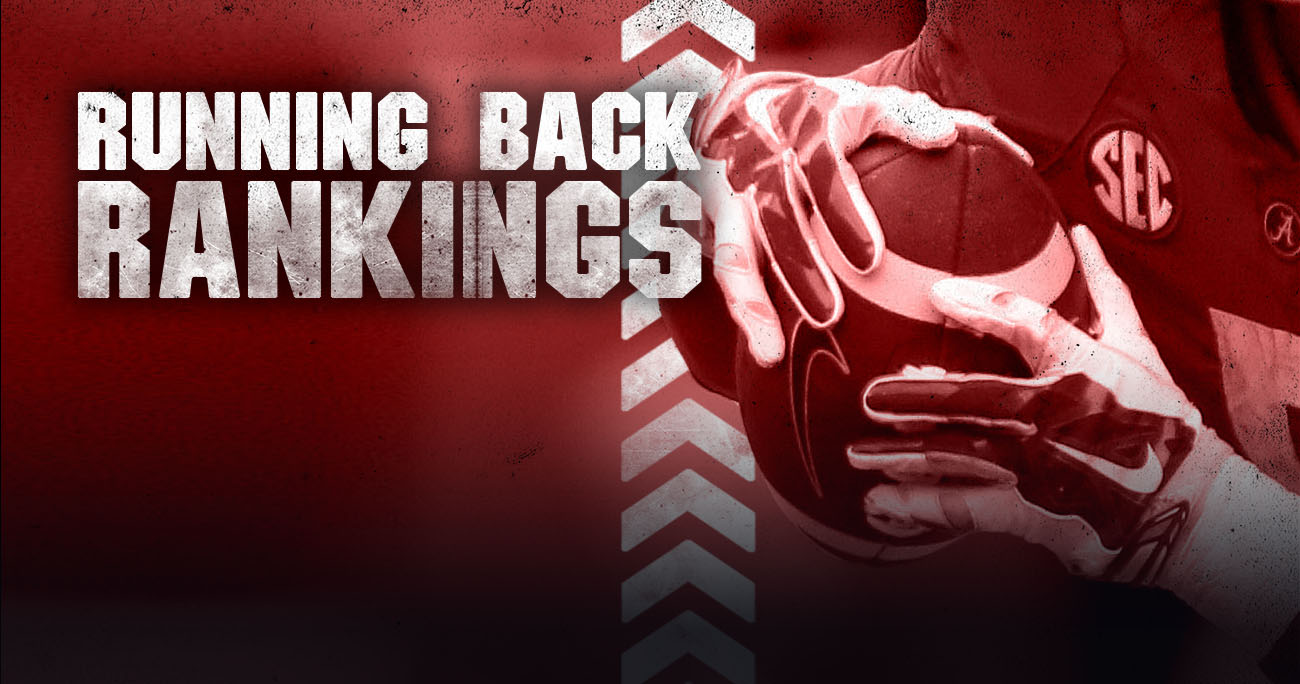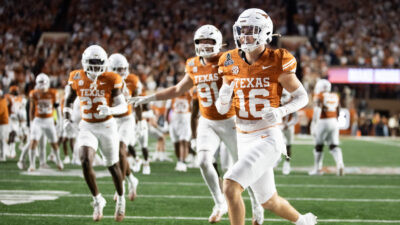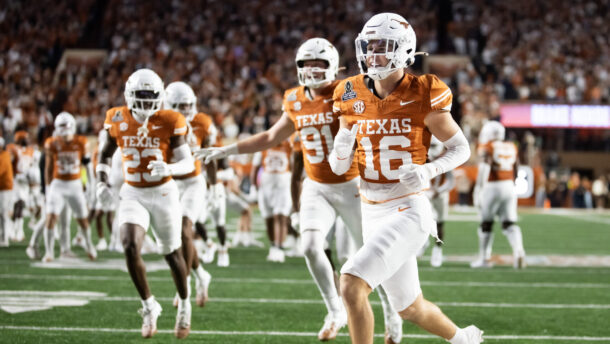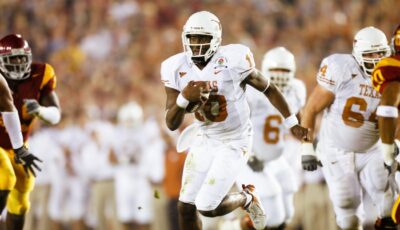
Judging the SEC running backs in 2015 is a case study in one’s football values.
Do you weight comparisons toward elite? If so, the SEC was a terrific conference for running backs this season. Do you value “top to bottom” depth, which SEC fans cite so often during arguments about the best conference? The SEC doesn’t look nearly as strong:
- Nick Chubb, Jonathan Williams and Russell Hansbrough, all members of our top 10 before the season, sustained injuries that prevented them from making our list.
- Alvin Kamara was efficient in short bursts and Jovon Robinson came on late, but neither has reached 100 carries yet, our unofficial minimum.
- Ole Miss, South Carolina and Mississippi State usually were not effective running the football and didn’t have a consistent top-end, every-down running back.
Still, if Chubb had remained healthy for even a few more games, the SEC would’ve had a trio of backs at the top like never before.
One of the more interesting takeaways from our top 10 list is that just one senior made it. All three draft-eligible juniors — Derrick Henry, Alex Collins and Kelvin Taylor — probably will enter the NFL draft. Barring another drastic shift in the sport’s foundation, the days of top-end SEC running backs playing four years are over.
Here are the top 10 SEC running backs in 2015:
10. Peyton Barber, Auburn: The last two Tigers running backs to start the season-opener went on to lead the SEC in rushing. Barber needs 24 yards in the Birmingham Bowl to become the eighth SEC back to reach 1,000, and still is chasing Florida’s Kelvin Taylor, who needs 15. He lost his leading role to JUCO transfer Jovon Robinson toward the end of the year. But he scored 11 touchdowns in a three-game stretch in the middle of the season that was a four-overtime loss from becoming a nice winning streak. He is a reliable offensive option for a team without many. He managed five 100-yard rushing games and exceeded most every expectation. Barber is a nice player that every SEC team would want.
9. Kelvin Taylor, Florida: Four of his five 100-yard games came after quarterback Will Grier’s suspension. That coincides with the stretch of the season in which the offensive line really labored, making it even more impressive. Everyone will remember him most as the player on the receiving end of a Jim McElwain tirade that could’ve peeled paint off a wall. Taylor wasn’t flashy, but he proved to be a durable between-the-tackles runner with a keen ability to reach the end zone, as his 13 rushing touchdowns indicate.
8. Boom Williams, Kentucky: The single-most explosive running back in the SEC, Williams also seemed to be a bit of an enigma. He missed time due to an elbow injury and came under scrutiny for his off-field behavior at one point. He managed 14 carries of at least 20 yards, more than any SEC running back not named Derrick Henry or Leonard Fournette. And he only carried 121 times, so his per-carry average is fourth in the nation among ball-carriers with triple-digit rushes. Kentucky’s offensive coordinator hire will be important for a number of reasons, and how it affects Williams’ role for 2016 is not the least of those.
7. Tra Carson, Texas A&M: Raise your hand if you’re not an Aggies fan and you realized that Texas A&M produced a 1,000-yard receiver. (OK, if you have your hand raised, you should probably spend more time socializing. Or at least spend an hour a day doing something other than pouring through college football stats.) Carson averaged 4.8 yards per carry and produced six 100-yard games. He gave the Aggies a physicality and a consistency that the team has been missing on the ground. It’s a shame that the passing game couldn’t live up to its potential, or else Carson would’ve gotten even more acclaim.
6. Sony Michel, Georgia: The biggest knock on Michel is that he’s not Nick Chubb. Defenses do not fear him. And unlike when Todd Gurley got suspended and injured in 2014, he didn’t keep the offense going as if nothing happened when Chubb went down. But forget all that and evaluate him in a vacuum. Despite offensive line play that lagged a bit in 2015, Michel topped 1,000 yards on fewer than 200 carries. He also caught 25 passes and served as a nice safety valve in a sometimes-impotent Georgia passing game.
5. Ralph Webb, Vanderbilt: He’s one of the biggest “what if” players in the SEC in 2015. The least imposing of the SEC’s top backs from a physical standpoint, Webb is listed at 5-foot-10, 202 pounds. As one of — or the only — offensive threat on Vanderbilt’s roster, playing behind a porous offensive line, Webb hasn’t enjoyed the best of circumstances. Yet, as a true sophomore, he ground his way to 1,152 rushing yards and 24 receptions. With just a little bit of help from the rest of the offense, he could become one of the top two or three backs in the entire conference next season.
4. Jalen Hurd, Tennessee: In a conference full of physical running backs like Leonard Fournette and Derrick Henry, Hurd can make a strong argument that he’s the most likely to lower his shoulder and barrel into a linebacker. At 6-foot-4 and 240 pounds, he’s every bit as intimidating to tackle as Henry. He should top 1,200 rushing yards in the Outback Bowl, and with four catches he’d reach 30 receptions in each of his first two seasons. He’s another player who has a chance at a historic season in 2016 with some improvement by his offensive teammates.
3. Alex Collins, Arkansas: At times this season, Collins made us wonder whether he belonged in the same conversation with Fournette, Henry and a healthy Nick Chubb. When Jonathan Williams broke his foot before the season, putting much of the burden on Collins, we figured he may face a tough second half of the season. Entering 2015, despite back-to-back 1,000-yard seasons, he’d never topped 100 yards in a game after September. He’s also found himself in coach Bret Bielema’s doghouse from time to time, and faced questions of whether he was always in top physical condition. Well, he really focused entering this season, and his preparation showed. He managed six 100-yard games after September, rushed for 17 touchdowns and earned himself a nice NFL pay check in what was his best college season.
2. Leonard Fournette, LSU: It’s hard to determine which harmed his perception more, a stunted performance against the Tide or LSU’s three consecutive losses. Either way, Fournette went from clear Heisman favorite to national afterthought in just a few games. I thought he was overhyped prior to facing Alabama, and now I think people underrate what he accomplished in 2015. He’s produced 1,950 yards of total offense and 18 touchdowns. His six runs of at least 40 yards are second-best in the country among running backs. If one or two breaks turned out differently, Fournette’s season would go down as one of the best all-time in the SEC. Still, we’ll remember this as the year he started living up to the hype in his post-high school career.
1. Derrick Henry, Alabama: Put aside his gigantic volume of carries and his unique ability to stay fresh deep into games. The thing that will set apart Henry’s 2015 season the most is how well he fared in Bama’s biggest games. Season opener against a power-conference foe on a neutral field? Good for 147 yards and 3 touchdowns. A much-hyped showdown in Athens against the SEC East favorite? 148 yards. A showdown for top status in the SEC against LSU? 210 yards and 3 touchdowns. Iron Bowl? 271 yards. SEC Championship Game? 189 yards. If the Tide win a national championship, one can make a legitimate case that Alabama rode Henry this season further than any one offensive player in coach Nick Saban’s tenure.
An itinerant journalist, Christopher has moved between states 11 times in seven years. Formally an injury-prone Division I 800-meter specialist, he now wanders the Rockies in search of high peaks.







